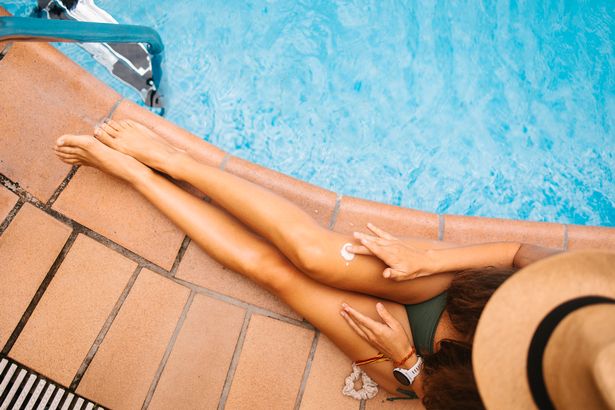Woman Embarrassed by 'Elderly' Diagnosis That Worsens in Summer - OK! Magazine

Varicose veins, those large bulging veins that can be seen pressing out of the skin, most commonly on the legs, affect up to 40% of UK adults. This condition often leaves many feeling self-conscious, especially during the summer months when the warmer weather has us reaching for our shorts, skirts, and swimwear.
It's already a struggle for women to feel confident in summer clothing, with a mere 16% admitting they feel comfortable donning shorts, even whilst on holiday. The presence of varicose veins only adds to this self-consciousness.
These veins bulge due to the pressure of the blood inside them and if left untreated, they can lead to swelling, ulcers, chronic pain, and an increased risk of deep vein thrombosis. They are caused by valve failure in leg veins, which is influenced by genetics.
Other contributing factors include age, sex, pregnancy, obesity, and spending long periods on your feet.
Venous surgeon Professor Mark Whiteley, founder of The Whiteley Clinic, explains: 'These other factors probably don't affect your risk of getting varicose veins, but increase the rate of deterioration,' reports the Mirror.
He further adds: 'Varicose veins tend to worsen in the summer. Warm temperatures cause veins to dilate as your body tries to release heat. This makes varicose veins bulge more and feel heavier. Dilated veins with weak valves allow more blood to pool in the legs, increasing symptoms such as swelling, tiredness, cramps and even new spider veins appearing.'
Longer standing or active days in the sun can further aggravate symptoms. Plus, compression stockings can feel stifling in the heat, so people avoid them, removing their benefit.
Here, Professor Whiteley shares his top tips for managing varicose veins during the warmer months..
Elevate your legs
When you're lounging in the sun or shade, try to elevate your legs whenever possible. Gravity assists the veins in pushing blood back towards the heart, which can alleviate the pooling of blood in the lower extremities. 'This helps reduce the pressure and discomfort associated with varicose veins and can also minimize swelling,' explains Professor Whiteley.
Take a dip in the swimming pool
If you're near water, take the plunge! According to Professor Whiteley: 'With an increase of the pressure from the water on your legs, your body has better circulation, which helps your veins move blood back up to your heart more efficiently than when you're on dry land. '
Consume citrus fruits
The abundant vitamin C content in oranges, lemons, and limes strengthens the vein walls and boosts overall circulation. 'Vitamin C is crucial for collagen and elastin production, essential for maintaining vein elasticity and preventing them from becoming weakened and dilated, which can lead to varicose veins,' Professor Whiteley says. 'Citrus fruits also contain flavonoids, which can reduce inflammation and improve blood flow.'
Consider a supplement
Micronized purified flavonoid fraction (MPFF) is a supplement that is composed of 90% diosmin and 10% active flavonoids. It is made from naturally derived extracts found in citrus fruits. 'MPFF works in a similar way to the benefits of citrus fruits and inhibits inflammatory processes and improves lymphatic circulation,' Professor Whiteley says. Supplements including diosmin and hesperidin can be bought online.
Keep cool
Prevent overheating by using a fan, remaining in the shade, and wearing lightweight clothing. Have baths and showers in lukewarm or cold water to encourage vein constriction. Lower temperatures trigger vasoconstriction, the narrowing of blood vessels. This constriction helps reduce the size of varicose veins, making them less noticeable and enhancing blood flow. You can also try placing chilled flannels on your legs for immediate relief.
Cat Sims, a 44-year old author and podcaster from London, shares her delight at finally feeling confident to show her legs off again.
“I've struggled with varicose veins since my early twenties but when I was about 25 years old I noticed they were becoming much more obvious visually.
Physically, I would get achy, heavy legs which was uncomfortable and frustrating because I was so young! They also got itchy in an unbearable way. I felt very self-conscious of my legs and rarely showed them off. I had no idea how to fix them or whether they could be fixed because no one talked about them, especially people my age at the time, and it was always just considered something I'd have to live with.
I would raise my legs up and ice them to try and alleviate the itching. If I had to get my legs out, I would use make-up and tanning products to try and hide them or make them less noticeable.
Summer is really hard because, of course, the weather was warmer, but I was reluctant to wear shorts or skirts or anything that would show my legs. The heat also seemed to make my legs feel more achy and heavy and the itching would intensify. It was just a constant low-level discomfort that really started to wear me down.
They’re hereditary in my family so it was inevitable that they would be a problem for me.
After about a year of suffering, I went to my GP. This was back when you could still get varicose veins stripped surgically on the NHS and they told you that you had to walk miles a day post-surgery. The recovery was awful. My legs were black and blue for two weeks and I remember feeling really unwell. When I got pregnant at 31, they all came back and worse. I just assumed from that point on that I was going to have to live with varicose veins and just manage the discomfort.
A friend introduced me to Professor Whiteley and I was blown away. It was clear that he was light-years ahead of the rest of the medical community when it came to understanding varicose veins and the viable treatments. It was such a relief when he said they could be fixed, and I didn't have to live with them.
First, he suggested we check for pelvic congestion via a scan which showed that I had four significant areas of varicose veins in my pelvis - a condition they called Pelvic Congestion Syndrome (PCS). I'd never even known that was a thing.
Professor Whiteley explained that if we didn't fix the congestion in my pelvis, the leg veins would always come back. So, via a vein in my neck, he inserted coils into the problematic veins in my pelvis. It was an outpatient treatment and done under local anaesthetic and was very quick with no recovery time.
After that, I was booked in to have the veins in my legs dealt with and again, it was done in a day. The recovery was a little longer and I had to wear compression stocking for three weeks but now, a year on, my legs are varicose vein free and I'm back in my shorts!
No more ugly green and blue lumps and bumps and no more pain. My pelvis also feels so much lighter - I didn't realise how heavy all that pooling blood felt in my pelvic area!
I am so confident about my legs now.




